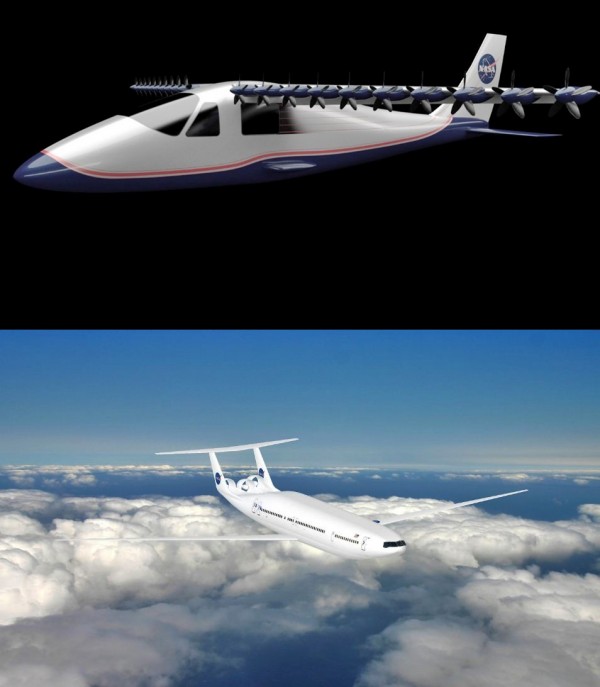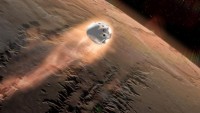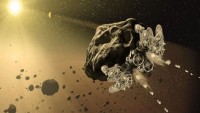NASA Reveals Future Electric Plane; 10 or More Engines will be Standard
| Arthur Dominic Villasanta | | Jun 17, 2016 08:09 AM EDT |
(Photo : NASA) The X-57 Sceptor, which has been renamed "Maxwell," and the D-8 all electric passenger plane
NASA is betting the face of future flight will be electric airplanes powered by up to 20 or more small engines that don't spew pollution; will be safer than gas guzzlers and will save airlines tons of money. They'll also have slimmer wings and might not have cockpit windows.
The space agency today revealed its all-electric plane concept that might do for the embattled airline industry what Elon Musk's Tesla electric sedans did for the struggling automobile industry. The electric airplane is the future of flight.
Like Us on Facebook
NASA has already revealed a lot about what it wants its prototype electric plane to look like. Today's reveal will just formalize that into a real aircraft.
Sources said NASA has temporarily named its first all-electric plane the "X-57" for the design phase of the project. NASA was expected to christen the commercial version of the X-57 as "Sceptor" but instead opted to name the aircraft "Maxwell" after Scottish physicist James Clerk Maxwell who formulated the classical theory of electromagnetic radiation in 1865.
Sceptor stands for "Scalable Convergent Electric Propulsion Technology and Operations Research." It's the name NASA used when its teams and its private sector partners were designing the aircraft.
NASA has not so secretly been working on Sceptor with a slew of aerospace companies over the past few years. This preliminary work means NASA might have a flyable, full-size experimental version of the Sceptor ready to fly as early as next year.
NASA envisions the commercial version of Sceptor as a nine-passenger aircraft with a 500 kilowatt (700 horsepower) power system ready to fly by 2019. The electric plane was expected to have as many as 20 electric motors driving its propellers but the version announced today will have 14 battery powered electric motors.
NASA also has ideas for an all-electric passenger airliner carrying over a hundred passengers. Its "D8 Series" future aircraft, nicknamed the "double bubble," will be used for domestic flights and is designed to fly at Mach 0.74 while carrying 180 passengers 3,000 nautical miles.
Building the prototype Sceptor involved removing the wing from an Italian-built Tecnam P2006T aircraft and replacing it with a specially developed "LEAPTech" wing integrated with 18 electric motors.
NASA Armstrong pilots flew a regular Tecnam P2006T in September 2015 to collect data to compare to the Sceptor. Once completed, Armstrong staff integrated the LEAPTech wing on Sceptor with electric motors for research flights.
Tests have shown the distribution of power among the 18 motors creates more than double the lift at lower speeds than traditional combustion engines.
NASA plans to fly a piloted Maxwell by 2017, replacing the wings and engines of a Tecnam P2006T with an improved version of the LEAPTech wing.
Maxwell might be a solution to greater fuel efficiency; improved performance and ride quality and aircraft noise reduction. NASA will play a vital role in developing those technologies for future flight over the next 20 years
LEAPTech, which stands for Leading Edge Asynchronous Propeller Technology project, is testing the premise that tighter propulsion-airframe integration made possible with electric power will deliver improved efficiency and safety, plus environmental and economic benefits.
TagsNASA, electric airplanes, Elon Musk, X-57, Sceptor, LEAPTech wing
©2015 Chinatopix All rights reserved. Do not reproduce without permission
EDITOR'S PICKS
-

Did the Trump administration just announce plans for a trade war with ‘hostile’ China and Russia?
-

US Senate passes Taiwan travel bill slammed by China
-

As Yan Sihong’s family grieves, here are other Chinese students who went missing abroad. Some have never been found
-

Beijing blasts Western critics who ‘smear China’ with the term sharp power
-

China Envoy Seeks to Defuse Tensions With U.S. as a Trade War Brews
-

Singapore's Deputy PM Provides Bitcoin Vote of Confidence Amid China's Blanket Bans
-

China warns investors over risks in overseas virtual currency trading
-

Chinese government most trustworthy: survey
-

Kashima Antlers On Course For Back-To-Back Titles
MOST POPULAR
LATEST NEWS
Zhou Yongkang: China's Former Security Chief Sentenced to Life in Prison

China's former Chief of the Ministry of Public Security, Zhou Yongkang, has been given a life sentence after he was found guilty of abusing his office, bribery and deliberately ... Full Article
TRENDING STORY

China Pork Prices Expected to Stabilize As The Supplies Recover

Elephone P9000 Smartphone is now on Sale on Amazon India

There's a Big Chance Cliffhangers Won't Still Be Resolved When Grey's Anatomy Season 13 Returns

Supreme Court Ruled on Samsung vs Apple Dispute for Patent Infringement

Microsoft Surface Pro 5 Rumors and Release Date: What is the Latest?













